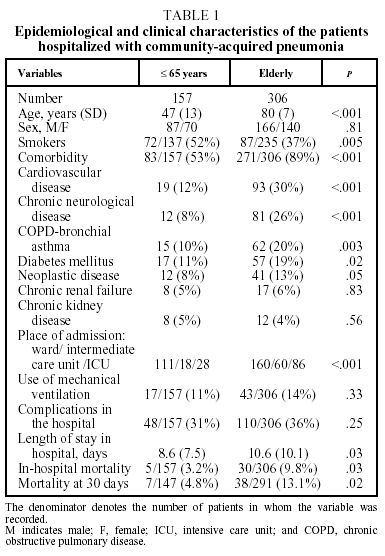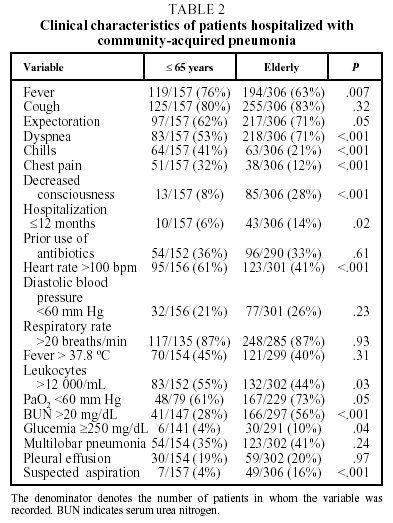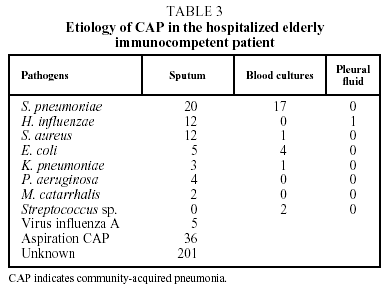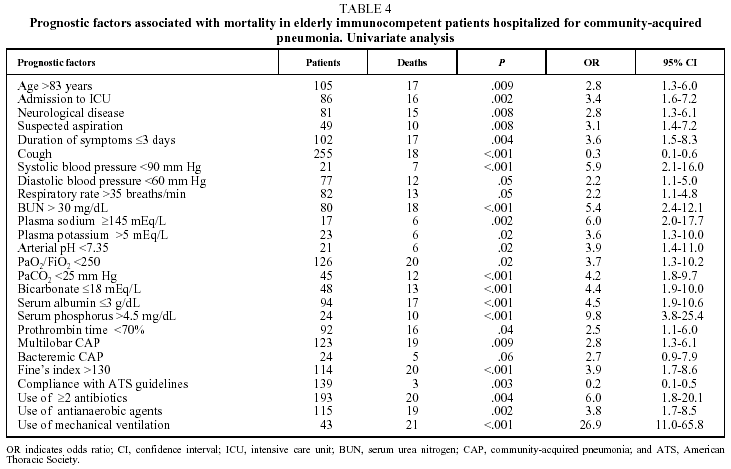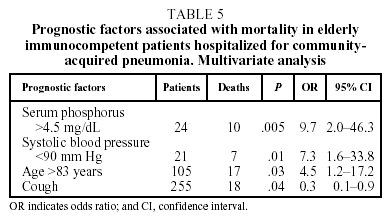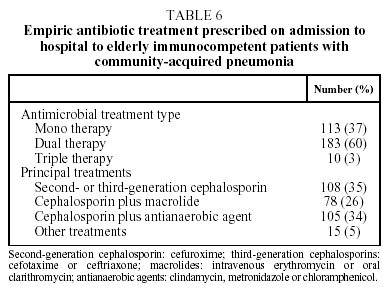Introduction
Community acquired pneumonia (CAP) continues to be a frequent cause of outpatient visits, hospitalization and death in the elderly population of first-world and developing countries.1-3 In Chile, pneumonia was the leading cause of death from a specific diagnosis in 1998, accounting for 87% of deaths in people over 65 years old.4 CAP represents a serious public health problem because of its high prevalence, the burden it places on the health system, and the lethal nature of the disease. Since CAP is not a reportable disease, no reliable information is available concerning its real incidence in the adult and elderly population in our country, and most of the research that has been carried out has studied groups selected from patients who had been hospitalized owing to the severity of their respiratory infection.5-8 In recent years CAP has been essentially characterized by the fact that it affects the elderly and patients suffering from chronic illnesses, such as chronic obstructive pulmonary disease (COPD), heart failure, diabetes mellitus, cerebrovascular and neoplastic disease or chronic renal insufficiency.1-4
It has been reported that the prevalence and mortality rate of pneumonia is higher in the aging population.9-12 However, advanced age is probably not the only factor that determines a bad prognosis for elderly patients with CAP.10-13 Other less well defined factors--such as the presence of multiple comorbidity, malnutrition, or an atypical or oligosymptomatic clinical picture--may be associated with a delay in diagnosis and consequently the start of antimicrobial treatment, which has an adverse effect on the course of the disease and the prognosis for the elderly patient with pneumonia. Very few studies have evaluated the clinical and epidemiological characteristics, prognostic factors and course of the disease in elderly adults hospitalized for CAP.9-17 The aim of this study was to describe the clinical features, prognostic factors and clinical course of CAP in immunocompetent elderly patients admitted to a university hospital in Santiago de Chile.
Patients and methods
A total of 306 elderly patients (>65 years old) and 157 adult patients (≤65 years old) were evaluated prospectively and consecutively. These patients were admitted to the Hospital Clínico de la Pontificia Universidad Católica de Chile (a teaching hospital with 520 beds) between June 1, 1999 and May 31, 2001 as a result of an episode of CAP. Immunocompetent adult patients (>15 years old) who met the diagnostic criteria for pneumonia defined by Fang et al18 and the hospitalization criteria proposed by the American Thoracic Society19 were included in the study. The diagnostic criteria for CAP referred to above are as follows: a) the presence of a new and persistent pulmonary infiltrate in a chest x-ray taken on admission; b) the presence of one or more major findings (cough, mucopurulent or hemoptoic expectoration, axillary temperature of over 37.8º C; or c) at least two minor findings, for example: pleuritic chest pain, dyspnea, decreased level of consciousness, lung tissue condensation observed in the physical lung examination, or a white blood count of over 12 000/mL. The following patients were excluded from the study: individuals positive for human immunodeficiency virus, patients with active neoplastic disease (solid and hematological tumors), neutropenia (leukocyte count <1000/mL), individuals who had received chemotherapy or immunosuppressant therapy (cyclosporin, azathioprine) during the six months prior to admission, or treatment with doses of ≥20 mg/day of prednisone or an equivalent medication during at least one month within the six months prior to admission. Also excluded were moribund patients in whom death as a result of the CAP episode was considered to be a foreseeable terminal event in the course of their chronic underlying disease.
The patients were evaluated on the first day of admission and periodically thereafter until they left the hospital or died. The following clinical and epidemiological information was recorded: age, sex, comorbidity, smoking, alcohol consumption, use of antibiotics prior to hospitalization (any dose received of an antimicrobial drug during the previous week), place of residence before admission (own home, nursing home, etc.), suspected aspiration (defined as any underlying clinical condition associated with sensory compromise, loss of cough reflex, or swallowing disorder), the clinical signs and symptoms presented on admission (fever, cough, purulent or hemoptoic expectoration, dyspnea, chest pain, mental confusion, chills), hospitalization during the foregoing 12-month period, and the presence of any acute concomitant disease (heart failure, arrhythmia, myocardial ischemia, bronchial asthma or COPD exacerbations). In addition, the following were recorded on admission to the hospital: place of admission (general ward, intermediate care unit or intensive care unit), vital signs, arterial saturation measured by pulse oximetry. The following laboratory tests were carried out at the same time: hematocrit, hemoglobin, leukocyte count, neutrophils, erythrocyte sedimentation rate, C-reactive protein, aspartate aminotransferase, alanine aminotransferase, alkaline phosphatase, lactate dehydrogenase, arterial blood gases, chest x-ray, serum albumen, plasma cholesterol, calcium, phosphorus, prothrombin time and kidney function. Patients´ clinical and epidemiological variables, laboratory results and the severity of their condition on admission to hospital were evaluated in relation to subsequent complications during clinical course and/or greater in-hospital mortality.3,10-17 Finally, the results of the following microbiological tests were recorded: Gram stain and culture of expectorated sputum, serial aerobic blood cultures, microscopic examination and Koch culture of sputum, Gram stain and culture of pleural fluid. Also recorded were the results of the serological studies requested for patients hospitalized with CAP in accordance with the clinical criteria of the responsible physician (a respiratory virus panel in the fall-winter period using direct immunofluorescent assay, IgG and IgM of Mycoplasma pneumoniae using indirect immunofluorescence, and urinary antigen of Legionella pneumophila serotype 1 by enzyme immune analysis). During this period, serological examinations were requested for only 10%12% of the patients hospitalized for CAP.
Two or more aerobic blood cultures were carried out for each of the patients included in the analysis. The bottles were incubated in a BacT/Alert® (Organon Teknika, Boxtel, Netherlands) automated blood culture system. The samples of sputum, blood and pleural fluid were grown on sheep´s blood agar, chocolate agar and MacConkey. Conventional methods were used to identify the pathogens and test their antimicrobial susceptibility.20 The breakpoints for the antibiotic susceptibility testing of the Streptococcus pneumoniae strains isolated from respiratory infections were defined in accordance with the standards of the National Committee for Clinical Laboratory Standards (NCCLS), USA, 1998.21
For the purposes of this study, the etiology of the pneumonia was classified as probable or definite in the following circumstances: a) isolation of a pathogen in blood or pleural fluid cultures (excluding Staphylococcus epidermidis); b) titers of immunoglobulin M serum antibodies of M. pneumoniae of ≥1:64; c) positive urinary antigen for L. pneumophila; d) isolation of a primary pathogen in respiratory samples using direct immunofluorescence (sputum, bronchial aspirate or nasopharyngeal swab); and e) cultures of sputum samples (adequate according to the criteria defined by Murray et al22) showing the development of a predominant pathogen.
Posteroanterior and lateral chest x-rays were taken of all patients on admission to the hospital. These were evaluated by a radiologist from the radiology department who participated in the study but who was unaware of the patients´ clinical situation. The radiographic pattern was classified as: a) alveolar infiltrate; b) interstitial infiltrate; or c) mixed pattern. The extension of the affected area was classified as follows: a) unilobar; b) multilobar (≥2 lobes); or c) bilateral. The presence of pleural effusion, abscess or cavitation was also recorded.
The severity of the patients' condition and their risk of death at the time of admission to hospital were assessed using the model defined by Fine et al.23 In short, the objective of Fine´s model is to predict mortality at 30 days in patients with CAP. Using Fine´s predictive rule, patients were classified into 5 risk classes, which correspond to mortality of between 0.1% and 31%. In general, outpatient treatment was recommended for patients identified as low-risk (classes I and II); a short stay in hospital or closely controlled outpatient treatment was specified for patients assigned to class III; and inpatient care was recommended for all patients in classes IV and V.
The following variables were recorded during follow-up in the hospital: microbial etiology, admission to the intermediate or intensive care unit, need for mechanical ventilation, medical complications (shock, empyema, myocardial infarction, arrhythmias, acute renal failure), length of stay in hospital, modifications to initial empirical antibiotic treatment, compliance with the American Thoracic Society´s Guidelines,19 and mortality in-hospital and on follow-up at 30 days. The cause of death was recorded as respiratory infection when death was caused directly by pneumonia or its complications (hypoxemia, adult respiratory difficulty syndrome, multiple organ failure, septic shock or acute renal failure).
Statistical analysis
Results for the variables measured on a numeric scale are expressed as means (SD) and those measured on a nominal scale as percentages. The qualitative variables were compared using the χ² test, and the continuous variables with the Student t test. The continuous variables were categorized. The predictive factors evaluated on admission were analyzed by univariate and multivariate analysis using a stepwise logistic regression model that contemplates the simultaneous control of multiple factors. Hence, the parameters that did not add a predictive value were not retained in the model. The interaction between variables was examined in the model; associated variables were not included in the analysis. The odds ratios (OR) and 95% confidence intervals (CI) were calculated. Differences between variables were considered significant when the P value was <.05.
Results
General characteristics of the elderly population
During the period covered by the study, 306 elderly patients with CAP admitted consecutively to a teaching hospital were evaluated. The clinical, epidemiological and radiographic characteristics are shown in Tables 1 and 2. The mean age was 80 (7) years (range 66101), 54% of the patients were males, 89% were suffering from concomitant diseases, 37% were smokers (40 [33] packets/y), and a third had been administered antibiotics before admission (in particular beta-lactams, macrolides and quinolones). Ninety-five percent of the cases were assigned to risk classes III, IV and V using the severity scoring system defined by Fine et al,23 28% were admitted to the intensive care unit, and 14% required mechanical ventilation. The mean length of stay in hospital was 10.6 (10.1) days (range 150), one third suffered medical complications during the course of the illness, 30 patients died in hospital (9.8%), and 13% had died on follow-up at 30 days.
Compared to adults of under 65 years of age hospitalized for CAP during the same period, the following findings were more prevalent among the elderly population: the presence of comorbidity, dyspnea, decreased level of consciousness, suspected aspiration, hypoxemia and high serum urea nitrogen on admission to hospital. In the elderly, admission to intermediate and intensive care units was more frequent, and the length of stay in hospital was longer. Multilobar radiographic involvement, pleural effusion, the complication rate and the need for mechanical ventilation were similar in both groups, but mortality, both in-hospital and on follow-up at 30 days, was higher in the elderly population (Tables 1 and 2).
Etiology of CAP
The etiology was identified in 22.5% of the cases of CAP (Table 3). Use of antibiotics prior to hospital admission did not affect the yield of the microbiological cultures. Serial aerobic blood cultures were requested for 249 patients (81% of the population), and a pathogenic agent was identified in 24 cases (9.6%). Gram stain and cultures of expectorated sputum were obtained for 144 patients. A microorganism was identified in 35% of the sputum samples that met the validity criteria defined by Murray et al.22 Microscopic examination and Koch cultures were carried out on sputum samples taken from one third of the patients; however, no Mycobacterium tuberculosis isolates were found. The pathogens most often identified in sputum, blood and/or pleural fluid were S. pneumoniae (10.5%), enteric Gram-negative bacilli (5.2%), Staphylococcus aureus (4.2%), Haemophilus influenzae (3.9%) and Moraxella catarrhalis (0.6%). All the strains of S. pneumoniae were susceptible to penicillin (minimum inhibitory concentration [MIC] <0.06 µg/mL) when tested in accordance with NCCLS guidelines,21 except 2 strains isolated in sputum and blood cultures that displayed intermediate resistance (MIC 0.1251 µg/mL), and 1 strain isolated in a blood culture that was highly resistant (MIC >2 µg/mL). Only 1 strain, which was isolated in blood culture, displayed intermediate resistance to cefotaxime (MIC 12 µg/mL), and 2 strains were resistant to macrolides and chloramphenicol. No strains were found to be highly resistant to cefotaxime. During the fall-winter epidemic period, influenza A virus was detected in 5 patients by direct immunofluorescent assay of a nasopharyngeal swab. Aspiration pneumonia was the diagnosis in 36 patients (12%), and there were no cases of postobstructive pneumonia associated with lung cancer.
Prognostic factors and mortality
Global mortality of the elderly patients hospitalized for CAP was 9.8% (Table 1). The cause of death was attributed to acute respiratory failure (37%), septic shock and/or multiple organ failure (63%). Twelve patients (40%) died during the first week; half of these deaths occurred during the first 72 hours of hospitalization. A third of the patients who died did so more than two weeks after admission to hospital. Mortality among patients admitted to general wards (4.3%) was much lower than among those admitted to the intermediate (11.7%) or intensive care unit (18.6%) (P<.001).
The variables shown to be associated with a higher risk of in-hospital death by the univariate analysis of the epidemiological, clinical, radiographic and laboratory variables evaluated on admission were as follows: advanced age (>83 years old), presence of neurological disease, suspected aspiration, short clinical history (≤3 days), absence of cough, arterial hypotension, tachypnea (>35 breaths/min), metabolic acidosis (arterial pH <7.35 and actual bicarbonate level ≤18 mEq/L), hypoxemia (PaO2<52 mm Hg with ambient FiO2), hypocapnia (PaCO2<25 mm Hg), elevated serum urea nitrogen, hypernatremia, hyperpotassemia, hyperphosphoremia, hypoalbuminemia, multilobar radiographic involvement, risk class V (patients scoring >130 on Fine´s index), use of two or three antibiotics at the time of admission, admission to the intensive care unit, and the need for mechanical ventilation (Table 4).
The independent clinical variables measured on admission that were still associated with a greater risk of in-hospital death in the multivariate analysis were: advanced age (>83 years old), systolic hypotension and high serum phosphorus; while the presence of cough constituted a protective factor (Table 5). Given that only 30 patients died, the inclusion of more than three or four variables in the multivariate analysis was not viable.
Antibiotic treatment
On admission to hospital, most patients were either treated with a single antibiotic (mono-therapy, 37%) or received dual therapy (60%). The mean number of antibiotics administered was 1.5 (0.8) (range 13). A total of 97% of the patients were treated with second- (cefuroxime in 84 cases) or third-generation (cefotaxime or ceftriaxone in 213 cases) cephalosporins (Table 6). In 27% of the patients, macrolides were administered concurrently (oral clarithromycin or intravenous erythromycin) to cover atypical pathogens (M. pneumoniae, Chlamydia pneumoniae, Legionella sp). One third received anti-anaerobic cover (clindamycin, metronidazole or chloramphenicol) due to decreased consciousness and/or suspected aspiration. Failure to follow the American Thoracic Society guidelines on admission to the hospital was a factor of bad prognosis (P<.005). Furthermore, the use of second- and third-generation cephalosporins in conjunction with anti-anaerobic agents on admission was associated with an increase in the complication rate and a higher in-hospital mortality rate (P<.001). However, this finding was not significant in the multivariate analysis because these antimicrobial treatments were used particularly in the patients whose condition was the most severe (Fine´s classes IV and V). On the contrary to what is described in the literature,24 the use of macrolides was not associated with a more favorable outcome and a lower risk of death.
Discussion
The main objectives of this study were to describe the clinical and radiographic features, etiology, prognostic factors and course of the disease in elderly patients with community-acquired pneumonia. CAP is the principal cause of death from infection in the elderly population, and constitutes a serious public health problem. The incidence of CAP in the elderly is higher than that observed in the young population, and it is a common motive for visits to emergency departments and for hospital admission. In our study, a high proportion of the elderly patients hospitalized for CAP were over 80 years old (53%), were suffering from concurrent diseases (in particular cardiovascular or chronic neurological diseases, diabetes mellitus, COPD, chronic renal failure and/or neoplastic disease), and corresponded to Fine´s risk classes IV and V (approximately 80%). It is important to note that almost half of the elderly adults were admitted to the intermediate or intensive care unit owing to the severity of their respiratory infection. Although this figure seems high compared to the situations described in other countries (10%-30%),3,10-13,17,19,25 mortality in the intermediate and intensive care units was 3-4 times that of patients admitted to the general wards, indicating that the patients admitted to these units really were the most serious cases. Mean length of stay in hospital was around 10 days, and in-hospital mortality was around 10%, similar to the figure given for other countries in the literature.1-3,10-13,15-19,25
Unlike younger adults with CAP, elderly CAP patients have a higher prevalence of chronic cardiovascular, neurological, and respiratory comorbidity and their need for admission to intermediate and intensive care units is greater. The elderly group scored higher on Fine´s prognostic index. Moreover, their average length of stay in hospital was longer, and mortality, both in-hospital and on follow-up at thirty days, was higher. The findings in this study are similar to the results of the meta-analysis of prognostic factors carried out by Fine et al.13 In the 14 studies in which they evaluated the relationship between age and mortality, the mean difference observed in the age of the patients who died was +7.8 years (range 0.615.4 years), and age was an independent risk factor for in-hospital death.
The etiology of the pneumonia was identified in only approximately 25% of the patients, especially by way of Gram stain and culture of sputum, aerobic blood cultures and culture of pleural fluid. The microbial isolation was lower than that published in the literature (50% to 60% diagnostic yield),3,5,10-12,17-19 probably because this study describes the usual treatment of patients hospitalized for CAP and does not correspond to an exhaustive trial protocol devised to determine the etiology of the lung infection. Similarly to what is reported in other studies, S. pneumoniae was the principal causative pathogen (10%), followed by enteric Gram-negative bacilli (5%), S. aureus (4%) and H. influenzae (4%). Unlike studies in other countries, which report a 20% to 30% prevalence of penicillin-resistant S. pneumoniae,26-27 in our population only 8% of the strains showed a high level of resistance to penicillin. These cases were treated with second- and third-generation cephalosporins, and the clinical course and complication rate was similar to those observed in patients infected with multi-sensitive pneumococci; there were no deaths in this group. In light of the fact that the blood concentrations achieved with intravenous penicillin and other beta-lactam drugs are considerably higher than the MIC for intermediate or high resistance,21 it is not surprising that the majority of studies show that high doses of penicillin or cephalosporins are effective in the treatment of pneumonia caused by strains of S. pneumoniae with intermediate resistance to these antibiotics. Recent studies have confirmed that the presence of resistance to penicillin and cephalosporins is not a determining factor in the prognosis of the patient hospitalized with pneumonia when the appropriate antibiotic is used;26,27 however, higher mortality has been observed in cases of CAP caused by resistant S. pneumoniae with a MIC of >4 µg/mL.28 Resistance to cefotaxime, macrolides and chloramphenicol was 3% to 5%, confirming the efficacy of these antibiotics in patients with pneumococcal pneumonia in our environment. No atypical pathogens (M. pneumoniae and Legionella sp) were identified probably because blood and urine serology for their identification was requested for only approximately 10% of the patients. Microscopic examination and Koch cultures of sputum were carried out in one-third of the patients, but no M. tuberculosis isolates were reported during the period covered by the study. Although tuberculosis is a chronic pulmonary infection, its clinical features can simulate an episode of CAP. The incidence of tuberculosis in the community varies widely. It has been proposed that it should be considered in the differential diagnosis in regions where the infection is still endemic, as it is in some areas of our country.
Consistient with what is described in the literature,1,3,10-15,19,23,24 the predictive factors of death from CAP in the univariate analysis were advanced age (>83 years), neurological comorbidity, suspected aspiration, short clinical history (<3 days), absence of cough, arterial hypotension, tachypnea, metabolic acidosis, hypoxemia, hypocapnia, raised serum urea nitrogen, radiographic evidence of multilobar disease, Fine´s risk class V, the use of two or three antibiotics at the time of admission, failure to follow the American Thoracic Society clinical guidelines,19 admission to the intensive care unit, and the need for mechanical ventilation. Some prognostic factors on admission not previously reported in the literature where hypernatremia, hyperkalemia, hyperphosphoremia and hypoalbuminemia; these findings were probably related to the severity of the infection and the underlying health status of the patients. In multivariate analysis, the following variables were still associated with a greater risk of death, independently: advanced age, systolic hypotension and raised serum phosphorus; while the presence of cough constituted a protective factor. These prognostic factors evaluated on admission to the hospital were also described by Fine et al in their meta-analysis of prognostic factors in CAP,13 which examined some 122 clinical studies on the subject. The risk factors with respect to hospitalization proposed by the American Thoracic Society19 and associated with slow clinical response and death include those described in this study: >65 years of age, comorbidity, arterial hypotension, tachypnea, hypoxemia, metabolic acidosis, deterioration of renal function and multilobar disease. This validates in our environment what has been reported in foreign literature.
In 1999, Ewig et al12 evaluated three prognostic rules based on variables measured on admission in 168 elderly immunocompetent patients hospitalized for CAP. These authors report that the rules proposed by the British Thoracic Society, which consist of groups of three variables comprising diastolic hypotension (diastolic blood pressure ≤60 mm Hg), tachypnea (respiration rate >30 breath/min), and elevated serum urea nitrogen (BUN >7 mmol/L) or mental confusion, demonstrated high specificity (>70%) and negative predictive value (around 94%), but low sensitivity (approximately 50%). Consistent with reports in the literature, three of these variables were significant in the univariate analysis in our study.
Fine´s rule, based on variables measured at the time of admission to hospital, was a good predictor of the complication rate and mortality both in the hospital and on follow-up at 30 days. There were no deaths among patients assigned to risk classes I and II, which are usually dealt with on an outpatient basis except when risk factors not considered in the model are suspected, such as the presence of an acute concomitant disease and/or problems of compliance with treatment. Neither were there any deaths in class III, mortality being concentrated in classes IV and V (12%), similar to the outcome originally described by Fine et al.23 These results are consistent with a report by Ewig et al12 that the Fine model made it possible to predict the duration of the hospital stay, the need to admit the patient to the intensive care unit, and the risk of death from pneumonia in the elderly population.
The clinical guidelines of the American Thoracic Society19 recommend using beta-lactam antibiotics in combination with macrolides in outpatients and inpatients suffering from chronic cardiopulmonary disease and/or who are at risk of infection by multiresistant S. pneumoniae. This recommendation is based on clinical trials that indicate that the outcome in patients treated with macrolides will be more favorable.24 However, in this study, the use of macrolides combined with beta-lactams had no effect on the clinical course or prognosis. Therefore, considering the low prevalence of multiresistant pneumococci in our population and the lack of information concerning the importance of atypical pathogens (M. pneumoniae, C. pneumoniae, L. pneumophila),7 no clinical and/or bacteriological basis exists as yet in our country that would support this expensive option.
In summary, CAP has a greater incidence, severity and medium-term mortality in elderly adults, making it a serious public health problem. This study describes the clinical and epidemiological characteristics, prognostic factors, etiology and clinical course of CAP in immunocompetent elderly patients requiring hospitalization, the findings of foreign studies are confirmed, and the need to carry out regional studies in order to rationalize the treatment of CAP in the elderly is stressed.
Correspondence: Dr. F. Saldías Peñafiel.
Departamento de Enfermedades Respiratorias.
Pontificia Universidad Católica de Chile.
Marcoleta, 345, 4.o piso.
Santiago. Chile.
E-mail: fsaldias@med.puc.cl
Manuscript received August 28, 2002.
Accepted for publication December 3, 2002.


